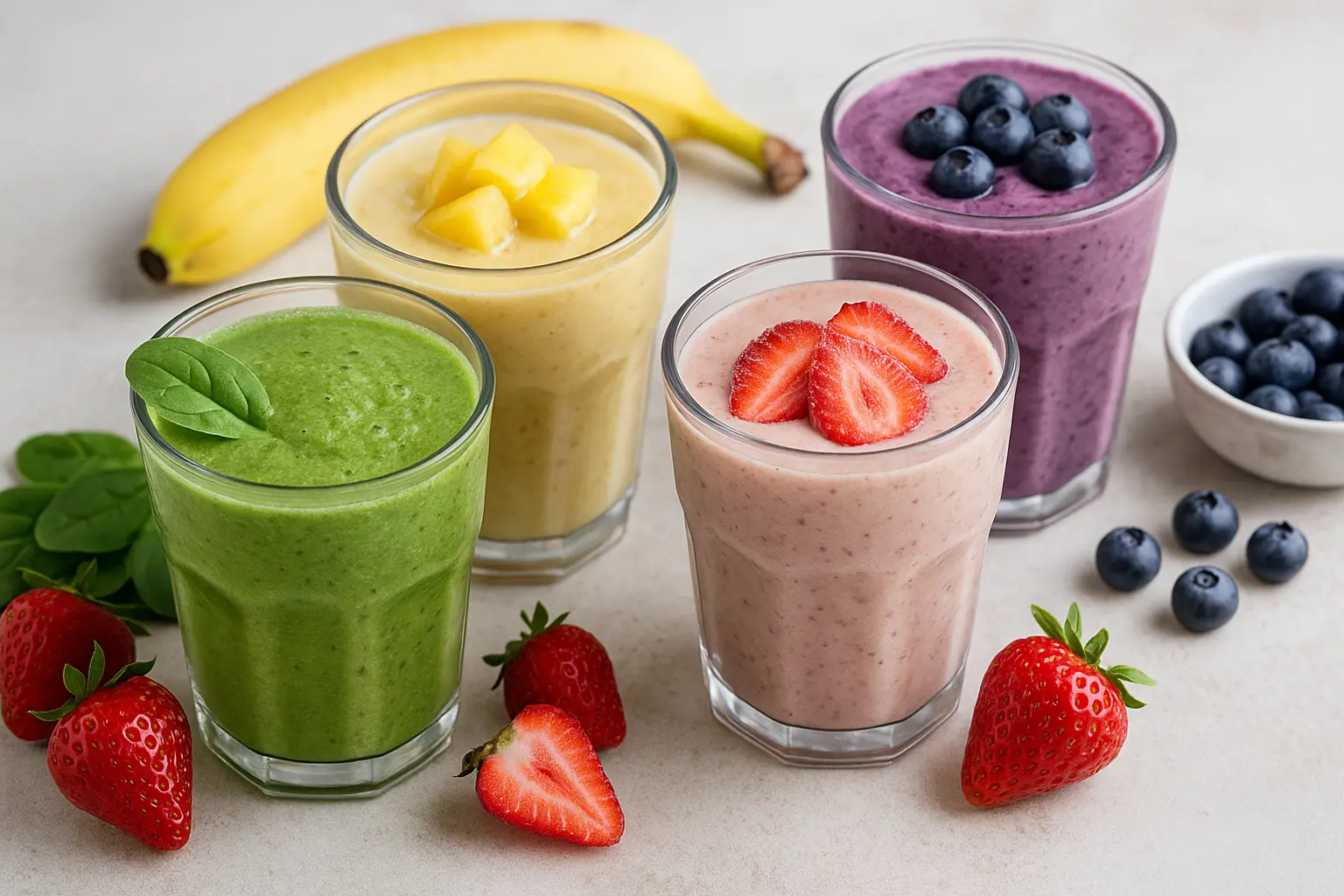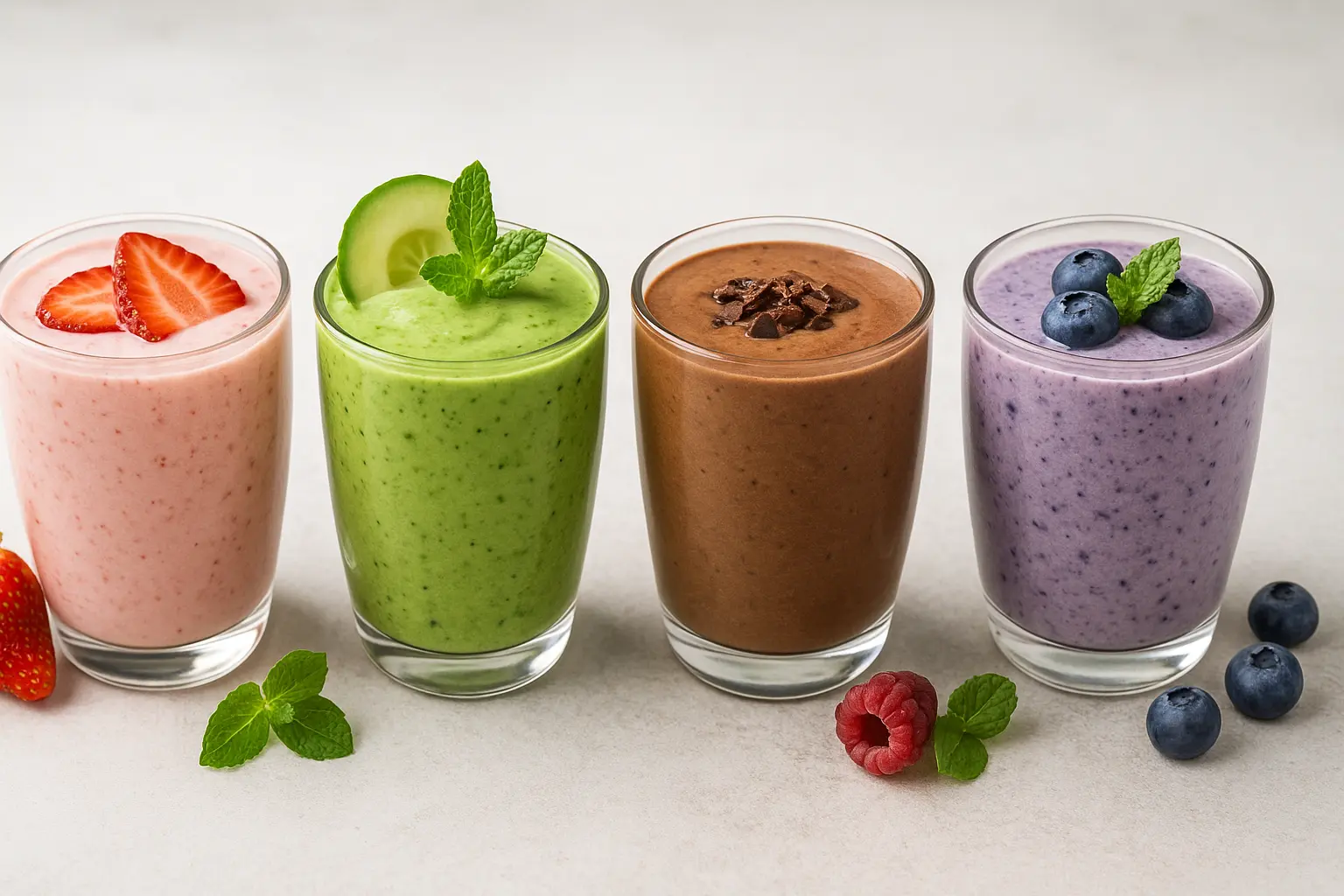Smoothies are often seen as sweet, creamy indulgences—something you might crave when you want dessert in a glass. But if you’re managing diabetes, not every smoothie is created equal. Many commercial smoothies are overloaded with sugar, processed syrups, and high-GI fruits that can send blood sugar levels spiking.
The good news? With the right ingredients and thoughtful preparation, smoothies can be both indulgent and diabetic-friendly. They can satisfy sweet cravings, deliver vital nutrients, and keep blood sugar stable. In this comprehensive guide, we’ll explore how to create smoothies that taste rich and creamy while being perfectly suited to diabetic needs.

Why Smoothies Can Be a Smart Choice for Diabetics
For someone with diabetes, food choices aren’t just about taste—they’re about balance. Smoothies, when crafted well, offer several benefits:
- Controlled Ingredients: You decide the fruit, liquid, and sweeteners.
- Nutrient Density: Packed with fiber, vitamins, minerals, and antioxidants.
- Satiety: Blended smoothies can be filling, especially when combined with protein and healthy fats.
- Customizable: You can make them a meal replacement, a snack, or even a dessert.
The key lies in mindful ingredient selection. A smoothie can easily go from health hero to sugar overload if made incorrectly.
Understanding the Basics: What Makes a Smoothie Diabetic-Friendly?
A diabetic-friendly smoothie keeps glycemic index (GI) and glycemic load (GL) in mind. It’s built to:
- Limit High-GI Fruits: Bananas, mangoes, and pineapples can spike blood sugar. Instead, use berries, green apples, or citrus.
- Add Fiber: Chia seeds, flaxseeds, oats, and leafy greens help slow digestion.
- Include Protein: Greek yogurt, cottage cheese, protein powder, or nut butter improve satiety and reduce sugar impact.
- Use Healthy Fats: Avocado, almond butter, chia seeds, and unsweetened nut milks stabilize blood sugar.
- Avoid Added Sugars: No honey, agave, or syrups—stick to natural flavors.
The Formula for a Perfect Diabetic-Friendly Smoothie
Think of smoothies as balanced meals in a glass. A reliable ratio is:
- 1 cup liquid base (unsweetened almond milk, coconut water, or low-fat milk)
- ½–1 cup low-GI fruit (berries, kiwi, green apple, citrus, etc.)
- 1 serving protein (20g protein powder, ½ cup Greek yogurt, or nut butter)
- 1–2 tbsp fiber or healthy fat (chia, flax, avocado, nuts)
- Optional flavor boosters (cinnamon, cocoa powder, vanilla extract, mint)
This structure creates creaminess, sweetness, and indulgence—without blood sugar spikes.
Top Diabetic-Friendly Smoothie Ingredients
Low-GI Fruits
- Berries (blueberries, raspberries, strawberries, blackberries)
- Kiwi
- Green apple
- Pear (in moderation)
- Citrus fruits (orange, grapefruit, lemon, lime)
Protein Sources
- Greek yogurt (unsweetened)
- Cottage cheese
- Protein powders (whey isolate, pea, hemp)
- Tofu or silken tofu
- Almond or peanut butter (unsweetened)
Fiber & Healthy Fats
- Chia seeds
- Flaxseeds
- Avocado
- Walnuts, almonds
- Oats (rolled or steel-cut, in moderation)
Flavor Boosters
- Unsweetened cocoa powder (for chocolatey richness)
- Cinnamon (supports blood sugar regulation)
- Vanilla extract
- Fresh mint
- Matcha green tea
12 Delicious Diabetic-Friendly Smoothie Recipes
Here are indulgent yet balanced recipes you can blend up at home:
1. Berry Almond Bliss Smoothie
- 1 cup unsweetened almond milk
- ½ cup blueberries
- ½ cup strawberries
- 1 tbsp almond butter
- 1 tbsp chia seeds
- Dash of vanilla extract
2. Green Glow Avocado Smoothie
- 1 cup unsweetened coconut water
- ½ avocado
- ½ cup spinach
- ½ cup cucumber
- Juice of ½ lime
- Fresh mint
3. Chocolate Peanut Butter Indulgence
- 1 cup unsweetened almond milk
- 1 tbsp natural peanut butter
- 1 tbsp unsweetened cocoa powder
- ½ frozen zucchini (adds creaminess without sugar)
- 1 scoop whey protein isolate
4. Citrus Sunrise Smoothie
- 1 cup water
- 1 small orange
- ½ grapefruit
- ½ cup plain Greek yogurt
- Dash of cinnamon
5. Strawberry Oat Cream Smoothie
- 1 cup unsweetened soy milk
- ½ cup strawberries
- 2 tbsp oats
- 1 tsp flaxseed meal
- ½ scoop vanilla protein powder
6. Spiced Apple Pie Smoothie
- 1 cup unsweetened almond milk
- ½ green apple
- 1 tbsp almond butter
- ½ tsp cinnamon
- Pinch of nutmeg
- Ice cubes
7. Matcha Coconut Cream Smoothie
- 1 cup unsweetened coconut milk
- ½ tsp matcha powder
- ½ avocado
- 1 tbsp chia seeds
- Vanilla extract
8. Blueberry Protein Power Smoothie
- 1 cup unsweetened almond milk
- ½ cup blueberries
- 1 scoop pea protein powder
- 1 tbsp flaxseed meal
- 1 tsp cinnamon
9. Creamy Tofu Berry Smoothie
- 1 cup unsweetened soy milk
- ½ cup raspberries
- ½ cup silken tofu
- 1 tbsp chia seeds
- Vanilla extract
10. Ginger Citrus Detox Smoothie
- 1 cup water
- 1 small orange
- 1 slice fresh ginger
- ½ lemon (juiced)
- Handful of spinach
11. Chocolate Avocado Delight
- 1 cup unsweetened almond milk
- ½ avocado
- 1 tbsp unsweetened cocoa
- 1 tbsp chia seeds
- ½ scoop chocolate protein powder
12. Raspberry Mint Cooler
- 1 cup unsweetened coconut water
- ½ cup raspberries
- Fresh mint
- 1 tbsp flaxseeds
- Ice cubes
Tips for Making Smoothies More Indulgent Without the Sugar
- Freeze your fruit: Creates a thick, ice-cream-like texture.
- Add spices: Cinnamon, cardamom, or ginger elevate flavor.
- Use extracts: Vanilla or almond extract make smoothies taste like dessert.
- Blend with ice: Gives a milkshake-like frothiness.
- Use cocoa powder: Adds richness without added sugar.
Common Mistakes to Avoid
- Overloading fruit: Too many natural sugars can raise blood sugar quickly.
- Adding sweeteners: Skip honey, agave, and syrups.
- Skipping protein: Without it, you’ll feel hungry sooner.
- Relying on fruit juice: Even unsweetened juice is high in natural sugar.
- Ignoring portion size: A large smoothie can mean excess carbs.
How to Make Smoothies a Regular Part of a Diabetic-Friendly Diet
- As a breakfast option: Pair with boiled eggs or wholegrain toast.
- As a snack: Half a smoothie between meals can prevent cravings.
- As dessert: A chocolate avocado smoothie can replace ice cream.
- Meal prep tip: Freeze smoothie packs with pre-measured fruit and greens—just add liquid and blend.
Frequently Asked Questions
1. Can diabetics have bananas in smoothies?
Yes, in moderation. Stick to ½ small banana combined with high-fiber and protein ingredients.
2. Is Greek yogurt a good base?
Yes, unsweetened Greek yogurt is low in carbs, high in protein, and adds creaminess.
3. How often can diabetics drink smoothies?
A few times per week is safe, especially if smoothies replace higher-sugar snacks or desserts.
4. Should I count carbs in smoothies?
Yes—carb counting helps manage blood sugar. Use a food tracker or measure ingredients carefully.
Conclusion
Diabetic-friendly smoothies don’t have to be boring or bland. By combining low-GI fruits, fiber-rich seeds, healthy fats, and protein, you can enjoy creamy, indulgent smoothies that satisfy cravings and support stable blood sugar. Whether you’re blending up a chocolate peanut butter delight or a refreshing citrus cooler, these smoothies prove that health and indulgence can go hand in hand.
Smoothies can become a staple in your diabetic meal plan—offering variety, nutrition, and flavor without guilt. Try the recipes above, experiment with your favorite combinations, and discover just how enjoyable diabetic-friendly eating can be.
Leave a comment
Your email address will not be published. Required fields are marked *




















